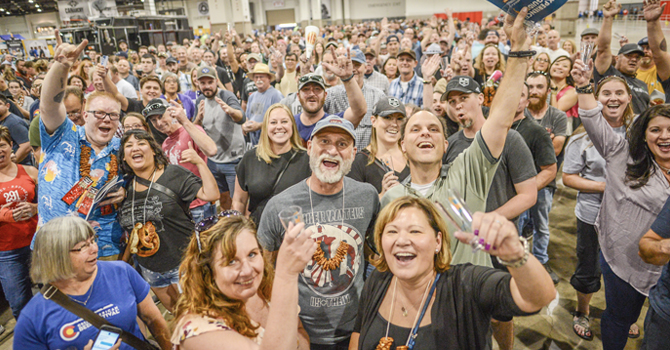
Last week’s Great American Beer Festival was the largest in history, as a record 62,000 attendees turned out to sample over 4,000 beers from more than 800 breweries that were set up across 584,000 sq. ft. space inside the Denver Convention Center.
The three-day, four-session beer festival featured an array of robust activations, including massive “events within the event” produced by deep-pocketed sponsors Jameson, owned by liquor company Pernod Ricard, and Buffalo Wild Wings.
“What you are seeing is that craft beer is maturing,” Julia Herz, the Brewers Association’s (BA) craft beer program director told Brewbound. “Brewers have every opportunity now to interface with groups that bring beer to market in a very large way.”
But beyond free wings and a never-ending supply of barrel-aged stouts, hazy IPAs, and sour ales, a few of storylines caught our attention throughout the week.
Here are three takeaways from the 2018 GABF:

A liquor company won the week
At the largest beer festival in America, it was a spirits brand — not a brewery — that emerged as the biggest winner.
The Pernod Ricard-owned Jameson Irish Whiskey label was omnipresent. Everywhere you went in downtown Denver, the company’s “Jameson Caskmates” program was visible.
In addition to setting up a nearly 13,000 sq. ft. beer garden on the GABF floor – an expensive activation area that featured 17 different barrel-aged beers, live music, games and snacks – Pernod Ricard backed up the Brinks trucks for advertisements and promotions across town.
Billboards – both analog and digital – near the convention center and on social apps such as Instagram displayed the Jameson Caskmates branding. Buses cruising along the 16th Street Mall were wrapped in advertisements, and Jameson Caskmates sandwich boards were spotted outside numerous bars
A VIP rooftop party featuring beer cocktails with the company’s signature Irish whiskey went down in the hours leading up to the Thursday evening session.
No matter how you slice it, Pernod Ricard spent a lot of money generating awareness for both its Caskmates offerings and its Jameson whiskey products. That investment comes at a time when the beer category has lost more than 10 percent market share to wine and spirits over the last two decades, and as the Brewers Association has barred large beer companies such as Anheuser-Busch InBev and MillerCoors from purchasing sponsorships.

‘Big Beer’ brands struck out
Historically, large domestic beer companies that do not meet the BA’s definition of what it means to be a “craft brewer” have dominated the American-style lager and light lager competition at GABF.
Just two years ago, three non-craft brewers — Pabst Brewing, Coors Brewing and Craft Brew Alliance – swept the American-style Lager category.
Fast-forward to 2018, and not a single mainstream lager brand won a GABF medal. The gold medal in the American-style Lager category went to Appalachian Mountain Brewery, which has a partnership with Craft Brew Alliance, but well-known offerings like Pabst Blue Ribbon or Coors Banquet were noticeably absent from the winners list.
“I think it shows that small brewers have game in the lager space,” Herz said.
Meanwhile, in the light lager category, Austin Beerworks took home a medal for the second straight year for its “Super Awesome Lager.”
As an increasing number of small brewers release beers that are intended to compete with more mainstream domestic products, the lager and light lager categories will become increasingly competitive.

GABF is no longer just a beer fest
The GABF has and always will be a chance for raving craft beer fans to sample rare and experimental beers, but this year’s event had more of a tradeshow vibe, some exhibitors noted.
Indeed, the days of brewers using the fest mostly as an opportunity to flex their creative muscles while showcasing innovative brews appears to be waning. We noticed a number of companies pouring easier drinking and more approachable styles, as well as their core offerings. And stalwart brands from near and far sent top brass to interface not only with consumers but other members of the trade.
We personally witnessed more founders, owners and beer company executives working their booths throughout the weekend, and a group like the Canarchy Craft Brewery Collective, which built a large activation area of its own, featured beers from all seven of its brewery partners who were co-located on the show floor.
Other regional craft breweries, including New Belgium and Left Hand Brewing, among others, built bright and inviting booths as a way of re-engaging drinkers that have migrated away from their beers in favor of those from newer players.
As the category approaches nearly 7,000 craft beer companies, the GABF feels like an event that will be increasingly used as an opportunity for established companies to engage the trade just as much as it will be a chance for those breweries to re-energize their flagship products.